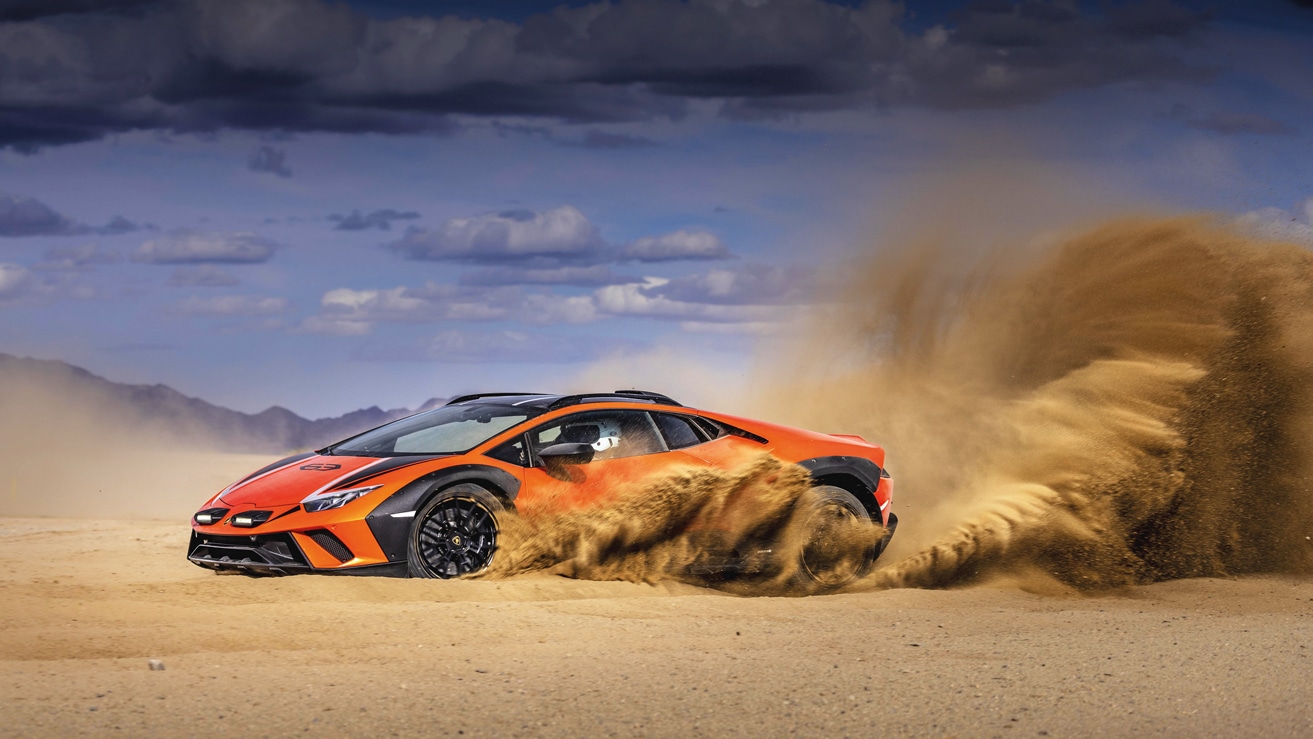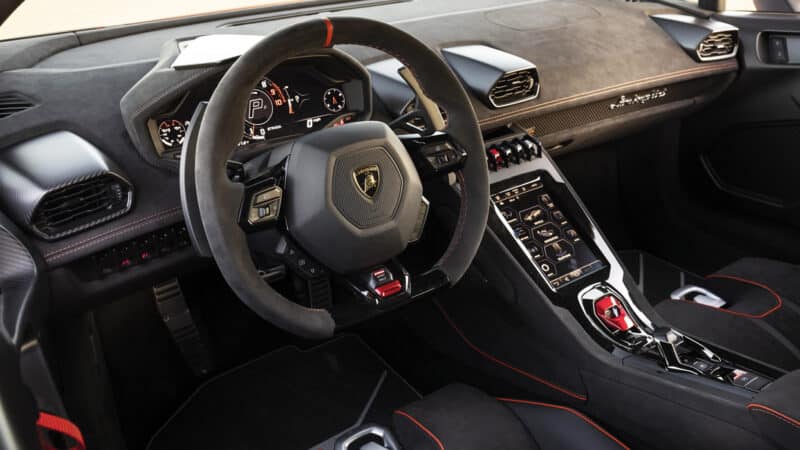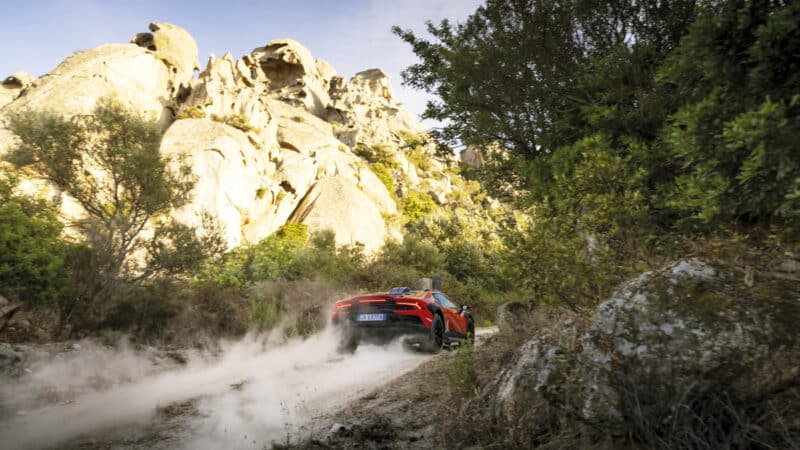2023 Lamborghini Huracán Sterrato review: dirt track supercar is recipe for fun
Does the world really need an off-road Lamborghini Huracán? Andrew Frankel wasn’t sure... until 60 seconds into his test drive

The Sterrato’s extra LED lights on the front, raised ground clearance and ruggedised bodywork might come in handy should you ever dream of taking it off-road
I try hard, as hard as I can, not to pre-judge cars. Let them stand or fall on their own merits rather than your preconceptions of how they’re likely to be. But sometimes it’s difficult, and this was one of those times.
The Lamborghini Huracán Sterrato, a transparent attempt to rekindle interest in a car that was never a patch on its rivals from McLaren and Ferrari. A little unkind? Maybe, and there have been one or two Huracáns I’ve genuinely enjoyed – the rear-wheel drive version in particular. But this isn’t even that. It’s an essentially standard all-wheel-drive Huracán jacked up to give it some ground clearance and some ugly plastic addenda to its body, spoiling the look of the car which was always its strongest attribute. Now in its tenth year was this really going to reveal itself as anything more than a last-gasp marketing department special intended to breathe life into an old dog? Well, now you mention it…
Of course Lamborghini is not the first to go down this path, following hot on the heels of the Porsche 911 Dakar as it does, but the Porsche looks effortlessly cool and it has the heritage to carry it off; the Sterrato (Italian for dirt road), does not.
Inside there’s little that’s substantially different. There’s some new information giving you your heading (already supplied by the nav) as well as your angle of incline and steering wheel angle (already supplied by your eyes). But apart from a new ‘rally’ driving mode that’s pretty much it.

Well, it’s a little different from Stig Blomqvist’s Saab 99 from the ’70s
The 5.2-litre V10 engine sounds fabulous, but then it always did, whether in the back of a Huracán or an Audi R8. It was the rest of the car I had a problem with. They’d been fast but remote, impressive at times but rarely endearing. A car to admire? Perhaps, for some. To fall in love with? Hardly. And isn’t that what an Italian supercar should be all about?
“You can do ridiculous things with the back end of this car”
But then I got over myself and took it for a drive. And in that instant everything changed. I knew within a minute that this was the best Huracán I’d driven. Five more and it was the best new Lamborghini since I’d been in the business, which includes everything from the Diablo forwards. After an hour I was having some fairly profound thoughts about it. Because it turns out this end-of-the-line run-out special has something to say. And for those who profess to love driving, it’s important. So I’d better tell you what it is.
The Sterrato sits on springs that are some 25% softer than those on a regular Huracán. Its tyres are narrower, taller and more heavily treaded too. It leans on its suspension which in turn leans on those tyres, and everything just gives a little bit, in a way no self-respecting supercar has done for many a year.
And when it does you are losing grip, you are losing lap time and on a bone dry road probably some traction too. But all this combined is as nothing to what you gain, which is a sense of oneness with machine that had me literally laughing in my still slightly uncomfortable seat.
It’s just so unexpected. A bit of roll and touch of sidewall squish puts you in touch with the road surface to an extent you’d need a Lotus Elise to match. It has the feel of cars invented before fat, sticky tyres demanded stiff, unyielding suspension – an old mid-engined Ferrari riding on Michelin XWXs. But unlike most XWX-shod mid-engined Ferraris, this one doesn’t do terrifying things on the limit.
On the contrary, and this is where the Sterrato became truly befuddling, the faster you went, the better it got. I was convinced that at race-track speed those soft springs and hybrid on/off road tyres would simply give up the struggle, leading to loss of body control and, probably, roll-induced snap oversteer. But it doesn’t. It just starts drifting. You can do ridiculous things with the back end of this car; the last time I drove a mid-engined car with four-wheel drive that was this controllable on the limit was over 30 years ago and it was called the Panther Solo. And all that without even trying it off-road in rally mode.
The lesson it teaches is that if you really enjoy driving, a more softly sprung car which breathes with the road, rolls just a little bit into corners and whose limits of adhesion are not so far away as to be inaccessible to all, is simply a better car to drive. Just more plain fun – and surely that’s what a car like this should all be about?
Or maybe not. A lesson will only be learned if its audience is willing to listen and I strongly suspect it’s not. Because I fear that for most, if not all in this high-end market, the idea of less actually being more will fail to compute, because what they actually want is something even lower, faster, meaner and more powerful.
Which is why brilliant cars like this will remain niche products, even in the rarefied world of six-figure supercars; but the truth is they deserve to be the ones from which all others are derived.

Refreshes the parts other Huracáns cannot reach
Lamborghini Huracán Sterrato
Price £232,820
Engine 5.2 litres, 10 cylinders, petrol
Power 602bhp at 8000rpm
Torque 413lb ft at 6500rpm
Weight 1545kg
Power to weight 392bhp per tonne
Transmission Seven-speed double clutch, four-wheel drive
0-62mph 3.4sec
Top speed 162mph (limited)
Economy 40.9mpg
CO2 337g/km
Verdict The 911 Dakar has a real rival.
